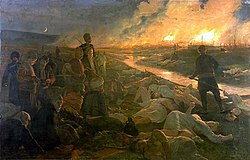Canonization
Canonization is a statement by a church saying that someone is a saint. This process is used by some Christian churches, most commonly in the Roman Catholic Church. The person must be dead, because living people cannot be canonized.
The process of canonization involves proving that the person lived in a way that justifies this decision. They must have loved others and loved God. In the Catholic Church, at least two miracles by the saint's intercession must be proven. This means that, because the person is believed to be in heaven, someone must pray, or ask, for the saint to pray for them in heaven. If the prayer is answered and a miracle happens, then they know that the person is a saint. The miracles prove that the saint must be in heaven with God, and able to ask God for prayers to be answered.
These people then enter into the canon, or list, of saints.
It is not correct to say that the Church "makes" someone a saint. The Catholic Church believes that anyone who is in heaven is already a saint. The canonization process just finds out for sure, or without a doubt, that someone is a saint.
Canonization Media
Icon of St. Cyprian of Carthage, who urged diligence in the process of canonization
Canonization of Elizabeth of Hungary in 1235. Sándor Liezen-Mayer (1863).
Pope Pius II canonizes Catherine of Siena.
The Turkish atrocities in Bulgaria (1876). On 3 April 2011, Batak massacre victims were canonized as saints.
Other websites
- Canonization of Saints Archived 2006-10-26 at the Wayback Machine - Describes the significance and process of canonizing saints.
- Entry on canonization and beatification in the Catholic Encyclopedia



